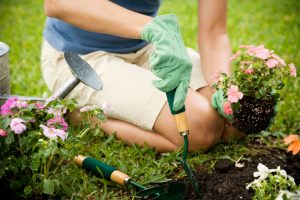
We all want our gardens to be clean and beautiful during the spring and summer, but it can be hard to keep up with when you’re struggling with persistent back pain. Below are some tips on how to take on gardening activities without straining your back. Keep reading for more on how to relieve back pain while doing yard work.
Gardening and back pain don’t have to be synonymous. Flare-ups, strain, injuries or just plain ol’ aches and pains may be due to things that you can control, namely your body mechanics.
Let’s review common gardening chores (digging, weeding, using a wheelbarrow, etc.) and how to do them in a safe way for your back.
1. Digging
When shoveling dirt (or snow, for that matter), you can minimize your risk for muscle strain or other back injuries.
This is all about using your weight as leverage. Here are a couple of tips on using good body mechanics and your body weight to successfully leverage the load:
- Start by establishing good body alignment. The first step, of course, is to take note of the direction your shovel spade is facing.
But it’s not enough to start with good alignment. You have to keep it as you do the work. A bit of body awareness goes a long way in this situation. - As much as possible, lean your weight into the shovel, rather than muscling through the whole thing. Most likely, you’ll tire less and less quickly this way.
- When it’s time to dump out the dirt, use your whole body, and not just your arms. (This is another way to avoid too much “muscling.”) It may seem easier to simply twist your body when getting rid of the dirt, but keep in mind that working this way may lead to a disc injury. Twisting the spine while carrying a load such as dirt or snow, and/or while bending forward at the spine—which often occurs when we’re not paying enough attention to our body awareness—are known risk factors for a spine injury. It may take practice at first, but try to walk around in a quarter or half circle and then release the dirt.
2. Weeding
Weeding is perhaps one of the most tedious of all gardening tasks. The good news is that numerous ways to reduce the possibility of strain and pain exist for this one—from sitting aids to strategies and more.
Let’s talk strategy.
If you have a sturdy bucket or a stool, grab it and use it! It will likely take pressure off your knees, hips, and even your back, as well as allow you to extend the amount of pain-free time you spend weeding.
That said, sitting can be precarious for some backs. The biggest key is to sit right on top of your sitting bones (you’ll know them when you feel them.) If you have to lean forward to grab a weed, try to do this action at your hip joint, and avoid rounding your back.
3. Lifting
When lifting something heavy—like big bags of soil—the first rule is to use your common sense.
It’s a discipline: Many a bag of soil is simply too much for your back. It’s OK to ask for help, and doing so may protect you from a painful injury.
When you do lift, make sure you’re using correct body mechanics as follows:
- Bend from the hips and knees, rather than the waist. The hips are more powerful and better equipped to deal with the load than the back.
- As you lower, keep your spine straight. If you are in the habit of bending over at the waist to lift, you may need to move slowly and with awareness to “get” this new way to move in your body.
4. Dumping a Wheelbarrow
Wheelbarrows are a handy thing, aren’t they? But before you empty yours, you might want to revisit the idea of leverage we talked about earlier.
Here are the basics of good body mechanics when dumping a wheelbarrow:
- Position yourself so that you’ll take the weight from underneath. This means using an underhanded grip.
- Bend from the hips and knees and keep your back straight to initiate the lift. Support the movement from the big, powerful muscles of your legs and pelvis.
- Once up, keep your spine long. Lean your body weight in toward the wheelbarrow to tilt the contents out. (This is the leveraging part.)
5. Mowing
Lawnmowers often need a bit of a push to get them out of inertia. And that push may have to come from you, depending on which mower you use.
Again, the key to this is to use your body weight as leverage. And as usual, keeping your spine long, while leaning your weight in towards the machine is critical for saving your back.
But there’s another element to good mowing bio-mechanics: the connection you make between your hands, arms, and the mower. A good connection will likely contribute nicely to your ability to lean in, to maintain a long spine and access your powerful hip and leg muscles as you walk your lawnmower through the grass.
Here are a few tips:
- Establish a neutral wrist posture. Your hands should be an extension of your forearms and be placed neither to the right or left of your wrist.
- Establish an elbow angle you can comfortably maintain, otherwise, you’ll likely engage more muscle tension than you actually need.
Gardening can be fun and rewarding, but it’s also hard work at times. Take some time to get knowledgeable and comfortable with using good body mechanics. Your joints will likely thank you for it.
Original article published on verywellhealth.com







